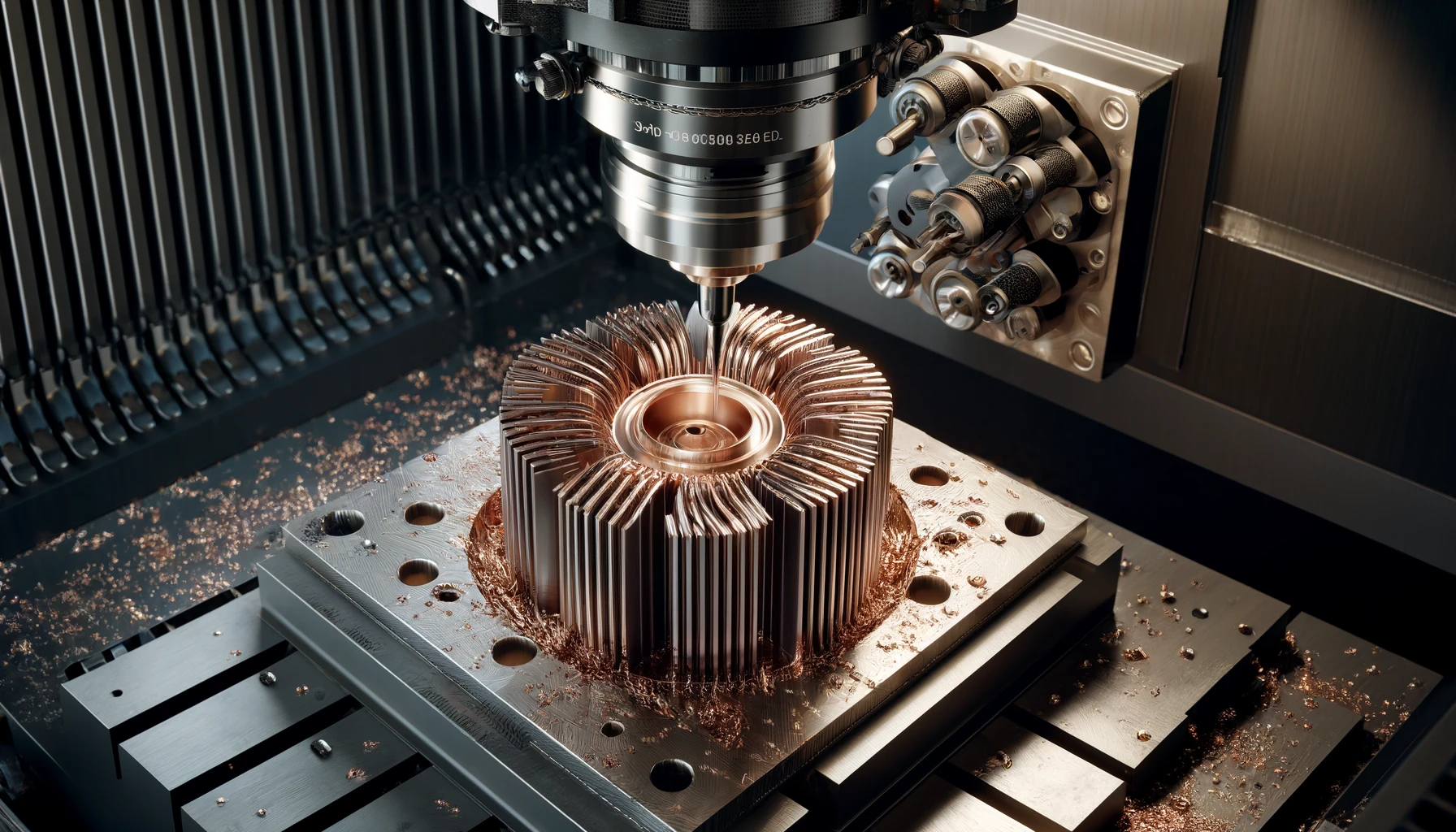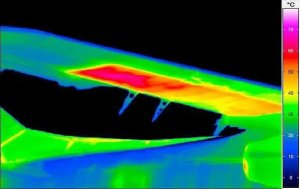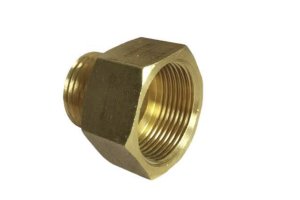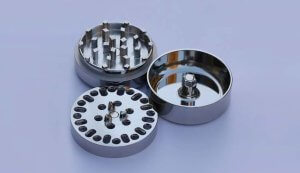Understanding the Technical Challenges in Machining Copper Heat Sinks
Copper heat sinks are crucial in various electronic applications because of their superior thermal conductivity. However, this same property makes copper challenging to machine effectively. Copper tends to adhere to cutting tools and can easily deform due to its softness, leading to work hardening and galling. Achieving precise and intricate designs requires highly skilled CNC operators who understand copper’s properties and can effectively manage the challenges posed by the material. For instance, multi-axis CNC machining is often required to machine complex geometries without deforming the soft copper material.
Advanced CNC machining requires the right equipment and skilled operators who understand the nuances of copper. Machines with high-speed spindles, superior tool holding systems, and effective cooling mechanisms are necessary to ensure precision machining and prevent defects. Adherence to cutting parameters is also essential in preventing tool wear and achieving desired surface finishes.
Why is Precision Key in CNC Machining of Copper Heat Sinks?
Precision is of paramount importance in copper heat sink production to ensure optimal thermal transfer. Copper heat sinks need to efficiently dissipate heat, which requires maintaining tight tolerances and specific surface finishes. Slight deviations in dimensions can lead to inefficient heat transfer, which can compromise the overall performance of electronic devices. CNC machines, with their ability to maintain high precision, are crucial in achieving this. A study showed that CNC-milled copper heat sinks with tolerances within ±0.01mm had a 20% improvement in thermal performance compared to less precise alternatives.
The importance of precision extends beyond dimensional tolerances. Surface finish directly impacts thermal transfer efficiency. A rough surface can create air gaps between the heat sink and the device, reducing thermal transfer. CNC machines can produce surfaces with a roughness of below 0.8 Ra, ideal for heat sinks to maximize heat transfer. This level of precision ensures that the heat sinks perform optimally, allowing devices to operate at their best performance.
What CNC Machine Features Are Essential for Copper Heat Sinks?
For effective copper heat sink machining, CNC machines should offer specific features:
- High-Speed Spindles: These spindles are crucial for high-precision cuts in copper, reducing tool wear and ensuring smooth surfaces. With spindle speeds ranging from 10,000 to 40,000 RPM, high-speed spindles enable efficient machining of copper, minimizing heat generation and achieving smooth surface finishes.
- Advanced Cooling Systems: Copper’s high thermal conductivity requires efficient cooling to prevent tool wear and material distortion. High-pressure coolant systems, which deliver coolant directly to the cutting edge, can improve tool life by up to 25%.
- Tool Holding Systems: Accurate tool holders minimize runout, ensuring consistent precision and reducing vibration. Balancing tool holders for high-speed operations is essential for minimizing vibration and achieving high-quality finishes.
- Multi-Axis Capabilities: Multi-axis CNC machines can machine complex geometries that traditional three-axis machines cannot handle. These machines allow for the precise machining of intricate heat sink designs.
- Adaptive Control: CNC machines equipped with adaptive control systems adjust machining parameters in real time, enhancing precision and reducing scrap rates.
- Automation: Automated tool changers and workpiece handling systems increase productivity by allowing for continuous, unattended machining.
How to Evaluate CNC Machining Services for Precision Copper Heat Sinks?
When evaluating CNC machining services for precision copper heat sinks, buyers should consider several key factors:
- Technical Expertise: Providers must have extensive experience in machining copper, understanding the challenges and nuances of working with this material.
- Machine Capabilities: The provider should have advanced CNC machines with the ability to maintain tight tolerances and handle complex geometries. Machines equipped with multi-axis capabilities are essential for intricate designs.
- Quality Control: Comprehensive quality control measures, such as CMM inspections and surface finish evaluations, are crucial to ensure the final product meets specifications.
Case Study:
A major electronics manufacturer required copper heat sinks with precise tolerances for their high-performance processors. They selected a CNC machining provider with a proven track record of producing high-quality heat sinks. The provider used multi-axis CNC machines equipped with specialized cooling systems and tool holders to produce heat sinks with tolerances within ±0.005mm. This precision enabled the client to enhance their product’s performance by 25%.
- Lead Time and Costs: Providers should demonstrate the ability to meet deadlines without compromising quality. Automated production and optimized tool paths can significantly reduce lead times and costs.
- Communication and Support: Clear communication and comprehensive technical support are vital for smooth collaboration and to ensure all requirements are met.
What Tooling and Process Parameters Optimize Copper Heat Sink Machining?
Tooling and process parameters significantly impact the quality and efficiency of copper heat sink machining:
- Tool Coatings: Coatings like TiN and DLC can reduce adhesion and tool wear, extending tool life. TiN-coated tools, for instance, can last up to 30% longer than uncoated tools in copper machining.
- Cutting Parameters: Optimized cutting speeds and feeds minimize heat generation and improve surface finish. High feed rates can reduce machining time without sacrificing surface quality.
- Coolant Selection: Using the right coolant, such as a water-soluble oil, can enhance surface finishes and extend tool life.
Tool Parameters Table:
| Tool Type | Coating | Speed (RPM) | Feed Rate (mm/min) | Tool Life Increase (%) |
|---|---|---|---|---|
| Flat End Mill | TiN | 15000 | 600 | 30 |
| Ball End Mill | DLC | 10000 | 400 | 25 |
| Face Mill | Uncoated | 8000 | 300 | 20 |
| Drill Bit | TiAlN | 6000 | 200 | 15 |
| Insert Cutter | CVD | 12000 | 500 | 35 |
| Reamer | Uncoated | 4000 | 150 | 10 |
| Chamfer Cutter | TiN | 14000 | 500 | 20 |
| Thread Mill | DLC | 10000 | 400 | 25 |
| Fly Cutter | CVD | 11000 | 450 | 30 |
| Bore Cutter | Uncoated | 9000 | 250 | 20 |
What Are the Quality Control Measures for Copper Heat Sinks?
Quality control measures are essential to ensure that copper heat sinks meet stringent specifications:
- Dimensional Inspection: Coordinate Measuring Machines (CMMs) are used to verify critical dimensions, ensuring the heat sink’s geometric accuracy. A precise CMM can measure features to within 1 micron accuracy, essential for maintaining tight tolerances.
- Surface Finish Evaluation: Surface profilometers measure surface roughness, which affects thermal transfer efficiency. Ensuring a surface roughness below 0.8 Ra is critical for optimal thermal conductivity.
- Non-Destructive Testing (NDT): Ultrasonic and eddy current testing can detect internal defects without damaging the part. NDT is essential for heat sinks used in critical applications where reliability is paramount.
- Metallurgical Testing: Metallurgical testing, such as microhardness testing and chemical composition analysis, can ensure the copper alloy meets the required specifications.
- Functional Testing: Testing the heat sinks under simulated operating conditions can ensure they perform as expected in real-world applications.
- Visual Inspection: A final visual inspection identifies surface defects, such as scratches or dents, which could affect performance.
What Are the Common Defects and How to Avoid Them?
Common defects in copper heat sinks include:
- Burrs: Burrs can form on the edges of heat sinks due to improper tooling or feeds. They can be minimized with deburring tools or by adjusting cutting parameters. A deburring process can reduce the likelihood of burrs by up to 90%.
- Tool Marks: Tool marks can result from tool chatter or incorrect speeds and feeds. Properly maintaining tools and optimizing machining parameters can significantly reduce tool marks.
- Surface Oxidation: Copper is prone to oxidation, which can affect thermal conductivity. Using appropriate coolants and storing the finished heat sinks properly can prevent oxidation.
Case Study:
A copper heat sink manufacturer faced significant issues with burrs and tool marks, impacting the efficiency of their products. By investing in deburring tools and optimizing their cutting parameters, they managed to reduce burr formation by 80%, significantly improving the heat sinks’ efficiency.
How Do CNC Machining Services Improve Lead Times and Costs?
CNC machining services can enhance lead times and costs through:
- Automated Production: CNC machines can run continuously, reducing lead times and improving efficiency. Automated workpiece handling systems allow for unattended machining, further improving productivity.
- Waste Reduction: Precision machining minimizes scrap, saving material costs. Automated tool path optimization can reduce material waste by up to 30%.
- Tool Life Extension: Using advanced tooling and coatings can extend tool life, reducing costs and improving efficiency.
- Adaptive Control: Adaptive control systems adjust machining parameters in real-time, ensuring consistent quality and reducing scrap rates.
- Design Optimization: CNC machining allows for rapid prototyping, enabling design improvements that can reduce material usage and simplify manufacturing.
Cost and Lead Time Optimization Table:
| Process Improvement | Lead Time Reduction (%) | Material Waste Reduction (%) | Cost Savings (%) | Tool Life Extension (%) |
|---|---|---|---|---|
| Automated Tool Paths | 30 | 15 | 20 | 10 |
| High-Speed Machining | 25 | 10 | 15 | 15 |
| Tool Coating Selection | 20 | 20 | 10 | 25 |
| Real-Time Monitoring | 35 | 25 | 30 | 20 |
| Adaptive Control | 30 | 30 | 25 | 30 |
| Automation | 40 | 35 | 35 | 35 |
Other Articles You Might Enjoy
- How to Choose the Right CNC Machining Partner for Manufacturing Copper Heat Sinks?
What Technical Expertise Should You Look for in a CNC Machining Partner for Copper Heat Sinks? CNC machining of copper heat sinks presents unique technical challenges due to the material's…
- What Criteria Define the Best CNC Machining Service for Precision Copper Manufacturing?
Understanding Precision CNC Machining for Copper The precision CNC machining process requires a deep understanding of the properties of copper. Copper is known for its excellent electrical conductivity, thermal conductivity,…
- Elevating Precision Standards through Chamfer in CNC Machining
1. Introduction: The Pursuit of Unparalleled Precision In the realm of CNC machining, precision is paramount. This section introduces the article by exploring the significance of precision in manufacturing and…
- Precision Prowess: Unveiling the Advantages of China CNC Machining
1. Introduction: The Role of Precision in Manufacturing Excellence In this introductory section, we delve into the critical role that precision plays in manufacturing and set the stage for an…
- Precision Engineering: The Advantages of Using Copper Alloys in CNC Machining
Introduction to Precision Engineering and CNC Machining Precision engineering is a discipline that aims at designing machines, fixtures, and other structures that possess high levels of accuracy and stability. It…
- Revolutionizing CNC Machining for Complex Aerospace Assemblies
Introduction to CNC Machining in Aerospace Assemblies Computer Numerical Control (CNC) machining represents a significant technological development playing a notable role in the creation of complex aerospace assemblies. CNC machining…









